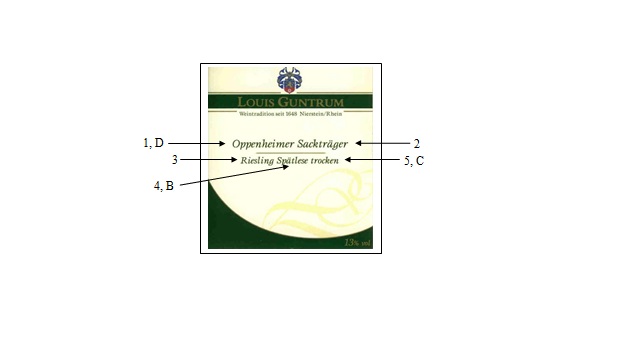GERMAN WINES – NO MYSTERY, BUT SHEER DELIGHT
BASICS ABOUT GERMAN LABELLING
LOUIS GUNTRUM – a family Estate, run and owned in the 11th generation by Louis Konstantin Guntrum. Producing wine in the family since 1648, we export our wines to more than 60 countries around the world.
A. How to read a German label (Refer to main picture above)
OPPENHEIMER SACKTRAGER RIESLING SPATLESE TROCKEN
1. OPPENHEIM – village name, see D. for details
2. SACKTRAGER – single vineyard appellation
3. RIESLING – grape variety
4. SPÄTLSE – quality level, see B. for details.
5. TROCKEN – dry. Halbtrocken = semi-dry. Without a characterisation, the wine is off-dry to sweet. See C. for details.
B. Quality levels
1. Tafelwein (table wine)
2. QbA = Qualitätswein bestimmter Anbaugebiete [Kvahl-it-ayts-vine buh-shtimt-er Ahn-bow-guh-beet-uh ] = Qualitätswein: Quality wine of a designated area
3. QmP = Qualitätswein mit Prädikat [Kvahl-it-ayts-vine mitt pray-dee-kaht ] = Quality wine with special distinction, comparable to the French AOC or the Italian DOCG. The quality levels depend exclusively on the degree of ripeness of the grape at the time of harvest. The degree of ripeness is measured in ° Oechsle and describes the content of natural sugar in the grape.
a. Kabinett [Kahb-in-et] – means “reserve”
b. Spätlese [Shpate-lay-zuh] – means “late harvest”, the lightest colour of the late harvest, riper than d-f below.
c. Auslese [Ouse-lay-seh] – means “selected harvest”, a selection of very ripe grapes, riper than Spätlese.
d. Beerenauslese[ Buh-air-en-ows-lay-zuh] – “selected harvest of berries”, meaning a severe selection of Botrytis-infected grapes, mostly dehydrated. This selection is only possible by hand.
e. Eiswein [Ice-wine] – A type of wine made of frozen grapes. The grapes for Eiswein have to freeze for at least one night at -7°C (about 15°F). The colder, the better. The grape juice is supposed to freeze entirely to concentrate flavours, sugar and acidity of the grapes and thus produce this outstanding wine. About 22 pounds of grapes are needed to produce 750ml of Eiswein, compared to 2.2 pounds of grapes for Kabinett or Spätlese wines.
f. Trockenbeerenauslese [Trock-en-behr-en-ows-lay-zeh] – “Selection of dehydrated grapes”, meaning only 100% dehydrated grapes through Botrytis are picked off the vine at the end of the season.
C. How to produce a TROCKEN wine:
The grapes are pressed to obtain grape juice. This grape juice contains lots of natural sugar and no alcohol. During fermentation, the yeasts will transform natural sugar into alcohol. Depending on the decision of the winemaker, the fermentation can be interrupted to obtain a wine with a certain amount of residual sweetness. If the fermentation continues, all natural sugar will be transformed into alcohol and the wine will end up being dry – trocken.
CAUTION: Trocken and Trockenbeerenauslese. The word “trocken” on its own means, the wine is dry (see 4.). In “Trockenbeerenauslese”, the part “trocken…” refers to the stage of grapes and describes, that the berries (beeren) have been completely dehydrated!
D. Vineyard / Wine names:
1. Oppenheimer Herrenberg
a. Village name: Oppenheim
b. Vineyard name: Herrenberg – Herr = The Lord, Berg = mountain
2. Oppenheimer Sacktraeger
a. Village name: Oppenheim
b. Vineyard name: Sacktraeger. Originating from the medieval guild of the “Sacktraeger”, the porters, that used to unload the barges on the Rhein river and carry the load to the castle on top of the hill. These porters – sack carriers – always took a certain path outside the town walls, on which the Sacktraeger vineyard is located.
3. Niersteiner Rehbach
a. Village name: Nierstein
b. Vineyard name: Rehbach. Reh = deer, Bach = creek. Rehbach = Deer Creek
by Louis Konstantin Guntrum, 9th October 2012

Subscribe To The Newsletter